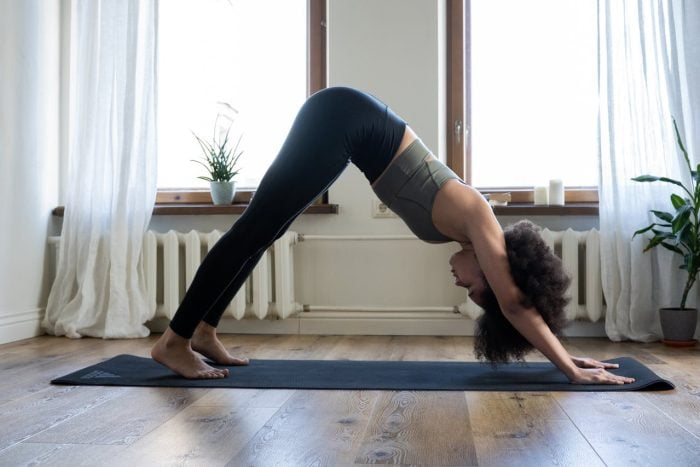{*Did you know you can write on Elephant? Here’s how—big changes: How to Write & Make Money or at least Be of Benefit on Elephant. ~ Waylon}
~
The tradition of practicing 108 Sun Salutations, or Surya Namaskar in Sanskrit, in a row is an ancient tradition with deep spiritual meaning.
A Surya Namaskar is a sequence of 12 powerful yoga asanas (poses) strung together to create consistent movement, typically found in Vinyasa-style yoga and traditionally practiced to usher in the new day, hence the name.
This practice is closely linked with the Hindu belief that 108 is a sacred number: there are 108 Upanishads (Hindu spiritual texts), 108 names for Hindu deities, 108 sacred points on the body (marma points) in Ayurveda, 108 sacred sites (pithas) in India, 108 beads on a mala (a garland of Hindu prayer beads), yoga pranayama is completed in cycles of 108, the distance between the Sun and the Earth is roughly 108 times the Sun’s diameter, and the distance between the Moon and Earth is roughly 108 times the Moon’s diameter.
Sun salutations can be practiced any time and with any frequency, but there are specific reasons to practice 108 Sun Salutations. The practice of performing 108 Sun Salutations is traditionally done on the two equinoxes and two solstices, celebrating the change of the seasons. Some people practice 108 Sun Salutations to celebrate big life changes and challenges like the birth of a child or a marriage so that one can embrace the positive energy and accept the challenges that may be faced.
The concept behind the 108 Sun Salutations is the same as behind the 108 mala beads. The person holding the mala touches each bead while repeating a mantra for a grounding, centering, and deep meditative experience. In the same way, you can perform a yoga mala—a meditative, repetitive yoga practice, the 108 Sun Salutations.
After years of practicing yoga, I decided to give this tradition a go and performed 108 Sun Salutations on my yoga mat, in the peace of my home on the day of the spring equinox last year. It took me about seven years of practice to finally get myself to it, and frankly, I was in way better shape and more flexible in my 20s, but mentally I wasn’t ready. The number itself scared the crap out of me. 108? I have to be crazy to do that. Or crazy devoted. Anyway, I finally ripened to give this a go. And I plan to keep on doing them.
Here are my tips and takeaways from my experience:
>> If you’re not used to extended yoga practices, repetitive movement, or are new to yoga, I recommend exploring different Sun Salutation sets (yeah, there are actually several variations of them—I know of 46).
I decided to go with the basic Surya Namaskar, which is great for beginners and it’s what I learned at the yoga shala where I got my yoga teacher certification. I chose this one because it’s the easiest for me to link my breath with my movement in a peaceful way and since it’s the best for beginner level, I can perform it with more ease (I do active physical work, hence my practices are rather on the restorative side now).
I can easily get into a flowy, meditative state, where my mind clears and I am focused on the breath and the movement. While during Sun Salutation Bs, I always get overheated, out of breath, and angry if I do too many of them (hello pitta dosha).
I started out by doing 20 in a row, before or after my regular yoga practice, and then worked up to 40 then 60. Sometimes I break up the 108 Sun Salutations into 9 sets of 12. The asanas are an invigorating cardiovascular workout after all, so it’s best to build up to it. Doing this before your first 108 ensures you’re physically prepared and can get the most out of it on the day you perform the whole 108.
But honestly, you’ll be surprised by your own strength and how many more rounds you can do than you’d expect yourself. Even if you may not reach that number the first time, give yourself credit for what you accomplished. Remember, it’s not an ego-centered but a heart-centered practice.
>> Just like with any kind of exercise, the most important thing is to hydrate. Not only during the event but start the day before. Drinking water on the day itself doesn’t do a whole lot, but making sure you’ve consumed enough water the day before helps your muscles and circulation be at peak performance. You can add a tiny bit of salt or electrolytes to your water as well. Have a water bottle nearby during the practice, but you don’t want to drink too much as that water can fill up your belly, slowing you down and making you feel weird during the practice.
>> If you can perform all 108 Sun Salutations in one go, great, but if not, it’s completely fine. Take a break whenever you require. It’s easy to get lightheaded from the repetitive up and down movements, especially if you perform them at a faster pace. Listen to your body and take rest in child’s pose when you need to.
>> Taking a break isn’t only important during the 108 Sun Salutations but also after performing them. It can be hard both physically and emotionally or mentally. Resting in savasana after and performing some wind-down stretches are beneficial for body and mind. I recommend ending with a seated or supine meditative pose, to reflect on the experience, instead of heading straight out into the world again.
>> During the practice, linking your breath with the movement is important. You will be able to fully connect with your breath and understand the significance of connecting breath with movement if you haven’t yet. The whole experience of a Sun Salutation feels different when you are in tune with the breath completely. I always feel more centered and grounded when I fully embrace the repetition and flow in synch with my breath, and I feel more connected to my true self this way. It is also said to be a way to connect with your third eye center, your guiding force and intuition.
>> The 108 Sun Salutations help you to move stuck or stagnant prana (energy) through your body. This will help you to be able to let go of things that no longer serve you, work through emotional processing, and release negative energy through your breath. I often get emotional or work through some old trauma when I do my Sun Salutations (or even during Ashtanga practice at times), so take time to check in with yourself after and maybe even journal it out. Hence I think the best thing is to perform this tradition on a weekend, where you are unbothered, or if you want to link it with the equinoxes and solstices, take a day off if they fall on a work day. Switch your phone off, so nobody can bother you meanwhile.
>> During the practice, you can use the power of a mantra to keep you going. As I mentioned earlier, you can use this practice as a full-body mala. Your mantra can be anything: “I am strong,” “I am wise,” “I am at peace,” “love,” “joy,” “So hum” (I am), or whatever resonates with you. Since it’s easy to get distracted in a repetitive practice like this, use your breath to focus on your mantra to keep you present. This will also help you to focus on the positive aspects of your practice, stay in the meditative mood, and the asana you are doing.
Now you are ready to get on your mat and ready to take on your first (or 10,000th) Sun Salutation, even if it ain’t 108; don’t forget to listen to your body and modify poses as needed. Work out a method that is the best for you.
Doing all 108 Sun Salutations took me over two hours to complete, but it was worth all the effort I put in it. There are no words to describe the ecstatic feeling afterwards, so I won’t even try.
~
{Please consider Boosting our authors’ articles in their first week to help them win Elephant’s Ecosystem so they can get paid and write more.}


 Share on bsky
Share on bsky





Read 1 comment and reply